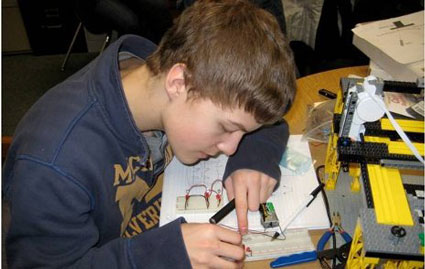| Feb 01, 2011 |
Enterprising high school students build AFM model from Lego bricks
|
|
(Nanowerk News) Nine students from Chassell High School know how an atomic force microscope works. In fact, they've built a model of one out of Lego™ bricks. They're the members of INANO (Identifying New Academic Nanotechnology Opportunities), Chassell High School's Enterprise team.
|
|
INANO is one of 16 High School Enterprise teams affiliated with Michigan Technological University. The program, headed by Doug Oppliger of the Department of Engineering Fundamentals, began in 2007 with just three teams. In four years, it has grown to include 16 high schools in the United States and Puerto Rico.
|
 |
| Chassell High School student Jared Jarvi working on the wiring of a "bread board" for a light sensor array. Part of INANO's Lego model is shown.
|
|
High School Enterprise is based on Tech's highly successful Undergraduate Enterprise program, in which teams of students work as a business to learn to solve real-world problems.
|
|
The goal of the program is to give high school students hands-on experience working in a professional environment. The hope is to generate interest in careers in the science, technology, engineering, and mathematics (STEM) fields, since more STEM-educated workers are needed to keep a country competitive in the rapidly changing global marketplace.
|
|
A High School Enterprise team is a four-way collaboration among students, industry, the community and Tech. Teams learn business and problem-solving skills by working to solve problems provided by the team itself or a company sponsor. The program is underwritten by a three-year National Science Foundation (NSF) grant, and Michigan Tech helps individual teams find local sources to fund their projects, such as industry partners and booster clubs.
|
|
New teams are added each year, and Tech hopes to continue adding more in the future. "I get inquiries almost weekly from school districts and other organizations who have heard about the program," says Oppliger. "We take these all on a case-by-case basis and try to put together a resource package to get teams off the ground. There is way more interest in the program than there are current funds to support teams."
|
|
The 2010-2011 academic year brought four new teams to the program. Dollar Bay High School in Dollar Bay, Mich., is designing and building remotely operated underwater vehicles to study the marine environment near their school. Benjamin Mays High School in Atlanta, Ga., is researching hydroponic gardening as a way to provide fresh produce in low-income urban areas. University Prep High School in Detroit is making an unmanned autonomous battery-powered vehicle. University of Chicago Woodlawn Charter High School in Chicago, Ill., is designing dwelling structures for developing countries that can withstand earthquakes.
|
|
INANO, the 9-member team from Chassell High School, works closely with Tech's Nanotech Innovations Undergraduate Enterprise. Nanotech Innovations taught the high school students how to use three different kinds of microscopes that can focus down to the nanometer level and helped them with the optical system. The Tech students also helped the high schoolers acquire parts to build a model of an atomic force microscope, which analyzes surfaces by bringing a small probe close to the surface and measuring its deflection due to forces between the probe and the surface. Now they are learning to program the model using National Instruments' LabView software and developing a light sensor and probe assembly that better represents an actual microscope.
|
|
This is Chassell High School's second year in the program. "I think the experience is pretty cool," says Mary Markham, the Chassell High School science teacher coaching the team. "Many of the students do not do as well on tests or in a regular class, but like doing and creating in the enterprise situation."
|

